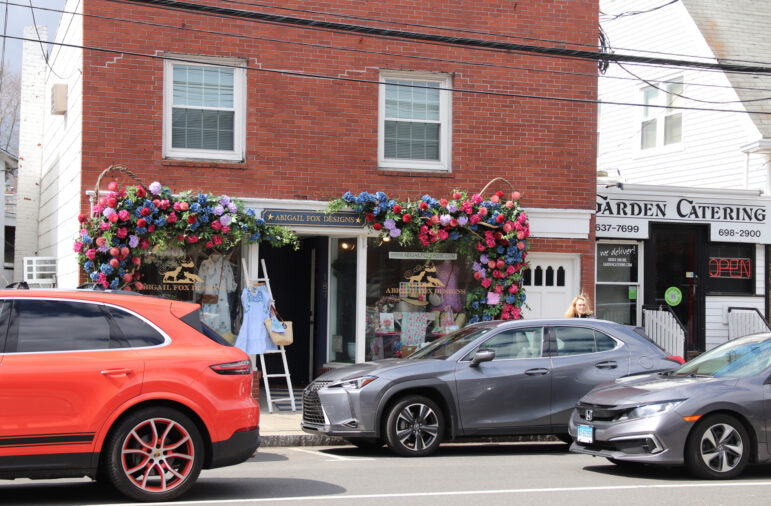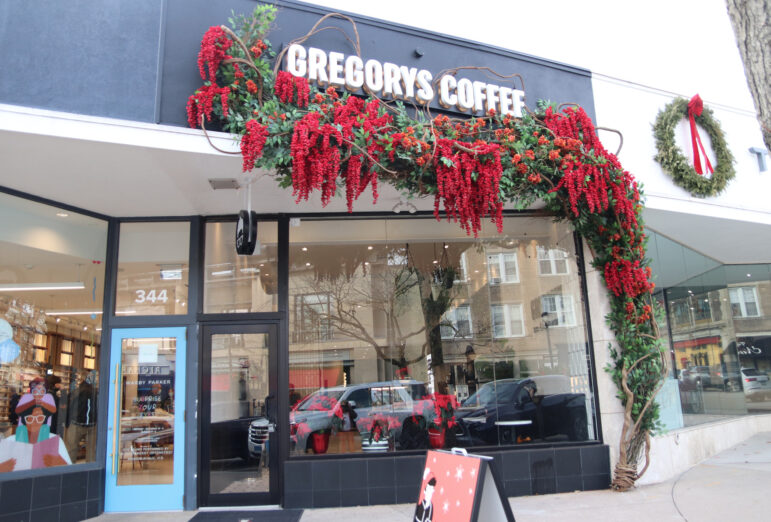Thursday’s public workshop on Greenwich’s regulations for signage and awnings hosted by Planning & Zoning and the Architectural Review Committee featured talk of rules and rule breakers.
While the event was in response to the furor caused by what many townspeople felt was one store being singled out for what they described as a classy and cheerful display of silk hydrangeas over a shop window in Old Greenwich, the conversation spread to plastic marigolds at a gas station, lights beaming out like a space ship from a store on Greenwich Avenue, and a flashing ATM sign in the window of McDonald’s – all perhaps not so classy displays that were perceived by some to be unenforced violations.
Dozens voiced their opinions via Zoom. At one point there were 85 attendees.
Not far into the meeting a 14-foot lobster made its way into the conversation.
Most, but not all of the conversation was civil and constructive.
And while some misunderstandings were cleared up, some residents just couldn’t get beyond the Abigail Fox floral display getting a violation.

While the meeting was a public workshop, rather than the type of public hearing required to change regulations, P&Z chair Margarita Alban said the town had issued an RFP for help researching updates to the regulations, including what other towns have on their books.
Rhonda Cohen from ARC said her committee strived to be empathetic to store owners while also ensuring their businesses, storefronts, signage and lighting met regulations and ordinances. She said they were all volunteers who live in town and considered themselves stakeholders.
Ms Cohen said ARC included professionals with long careers as architects, landscape designers and lighting designers. Her experience was in graphic design and visual identity, logo development and photo art direction.
“Greenwich is built on a set of values. Most important is authenticity. Some of the words many of us have used to describe our beloved town are beautiful, natural, simple, quiet, safe, calm, historic, manicured gardens, serene, bucolic, an element of privacy, and very civic minded,” she said. “With that, the segue would be, as merchants, we all have a civic responsibility to present our shops in a way that is consistent with the values and qualities and attributes of our town.”
Cohen talked about the a balance between making sure shop owners have a visual identity people will notice, and respecting the values that give Greenwich its identity.
“That’s where regulations come into play,” she said.
And while violation for the artificial flowerdisplay at Abigail Fox Designs triggered the outcry, P&Z director Katie DeLuca said several storefronts with displays of artificial flowers had also received violations.
Ms DeLuca said the first time floral displays came up was when Bistro V asked permission to erect one and was denied. At that point, she said Gregorys Coffee had already received a violation. Later Abigail Fox received her violation, followed by Something Special and Love Shack Fancy.

ARC chair Richard Hein said there had been a merchant with a lobster business who proposed a 14-foot 3D lobster.
“He thought would be perfect on the front of the building,” Hein said. “At the end of the day, the committee didn’t think so.”
P&Z commission chair Margarita Alban said despite the rumor, it was not a business competitor who complained about the Ms Fox’s floral display, but rather members of the committee researching the regs.
“The folks on this committee all went out and took pictures of signs and lighting, and whether people had fluorescent and blinking lights,” she said. “That’s how that came up – the stores with flora,” she said. “You were not turned in by a competitor.”
Unlike the red ‘stop work’ orders at construction sites, for example, violations for signage or eye catching devices aren’t posted, and sometimes business owners decline to comply with a violation so the perception lingers that there is no violation.
Ms Deluca explained the enforcement process.
“The truth of it is it’s not as much of a deterrent as it needs to be,” she said. “You get a letter noting that you’re in violation and have time to respond – usually about 30 days. Then you get another letter, and then a case-and-desist. And then it goes to the state’s attorney office, and they can arrest you. That has happened twice.”
DeLuca said that while the community input was important, the rules were also important, and stemmed from input at past meetings.
“We have to, as a community, follow the laws of the community, and go about the process to change rules if need be,” she said. “We have three enforcement staff for a large town and much more important things than visual clutter, but it’s a very upsetting thing to drive through a community and see that visual clutter.”
As residents each took their three minutes to opine, some themes emerged.
People talked about perceived ambiguity of the rules and finding out they’d been broken after the fact.
Frederick Baker from Old Greenwich, who said he thought Ms Fox’s flowers were wonderful, said, “We’re starting way down in the weeds on regulations. Could somebody on your staff articulate in a simple way what the regulation is on flowers?”
Ms DeLuca described the two situations where business owners can request permission to put up what the town calls eye catching devices.
One is for one 7-day period throughout the year, such as for a big sale or a new store opening. The other is for a 40-day period during the holiday season.
Of the three enforcement officers who cover the entire town, DeLuca explained their priorities were health and safety situations.
“Their priority isn’t someone’s sandwich board sign,” she said. “We have greater problems such as illegal units.”

“We don’t allow things like big lobsters coming out of a wall, or the big floating balloon man at a car dealership. I think we can all agree we don’t want that,” she said. “When we create a regulation – if we were to do something about the flowers – we would have to do it in a very specific way.”
Noting the gas station’s yellow artificial Marigolds that had gone up earlier in the day, she said the business owner had previously been told they had to be removed.
She said there was a concern about allowing floral displays. “You might get something outlandish,” she said.
She said the basic purpose of the sign regulations was to provide “wayfinding,” and “eye catching devices” were not allowed.
Matthew Tallett from Pemberwick said some terminology in the regulations was confusing.
He suggested if all the rules were made clearer and communicated to business owners, the town could achieve “cohesiveness” along the lines of Nantucket or, closer to home, Armonk in New York.
“Once we start defining what we are looking for here, it’ll start to fall into place,” he said.
Ms DeLuca noted that Nantucket is in Massachusetts and Armonk is in New York. Both states have different laws than Connecticut.
For example, she said, “New York can regulate single family homes and what they can look like. We don’t have the police power to do that.”
Jason Palmer, who has owned Petticoat Lane on Greenwich Ave 26 years, said it would be helpful if the town distributed a simple summary of what was and was not allowed, along with contact information at town hall.
“I don’t want to get in trouble for putting some flowers around the dirt out there,” he said.
Marcos Torno said years ago, when he first opened Images in Old Greenwich, someone told him his freshly painted gold door had to be to white.
He complied, but later learned the requirements were part of an unofficial agreement among merchants. He said he’d always wondered how Dunkin Donuts and the former Bank of America got away with their respective pink and red signs.
Michael Duda from Riverside, whose business does marketing and funding for entrepreneurs said, “It’s almost like a nail through my heart when I hear ‘eye catching devices.’”
Mr. Duda suggested the town use Instagram to disseminate the rules for merchants. He said it was very unfortunate that the Town of Greenwich’s official Instagram account had featured a photo celebrating Abigail Fox Designs floral display.
“We have some very attractive ones, but also some reasons you might want parameters in place,” Alban said. “Also, when a reg is 30 years old, sometimes that’s very good because it means it works for the town.”
“I gather 30 year old regs that don’t contemplate this,” said Marianna Ayres. “We do know that the town can be nimble when necessary, as was the case with restaurants in the midst of Covid. Small businesses were forced to close, such as Ms Fox’s business. There should be the same nimbleness shown here as well.”
Ms Ayres argued the regs didn’t apply to Ms Fox’s artificial flowers anyway.
She cited section 6-170 of building zone regs, which refers to prohibitions on pennants, banners, spinners, streamers, moving signs, ground signs, sale signs, special promotion signs and other eye-catching devices, as well as signage for new openings, new management, and special promotions events, and finally, a prohibition on search lights. And she mentioned section 6-163, which talks about traffic hazard, marquees and lighted signs.
“Having read these, I would say your regulations don’t even apply to what Ms Fox put up,” Ayres said. “You couldn’t enforce this.”
“Maybe there are people who hate plastic flowers who are using this particular set of regulations to expand its applicability, but it doesn’t even apply to Ms Fox,” Ayres continued, adding that she believed Ms Fox’s flower arrangement didn’t promote her because she doesn’t sell flowers.
“It is not a banner. It’s not a pennant. It’s not a spinner. It’s not a streamer. It’s not a moving sign. It’s not a ground sign. It’s not a sale sign. It’s not a special promotion sign. And eye-catching is in the context of a promotional event and promoting your business.”
Don Raftery asked if the town might allow Ms Fox’s floral display to remain in place while regs were being updated.
“Given the understanding that perhaps there is too much ambiguity in the rules and we’re hiring a consultant to re-craft and reshape the rules to make them better, can we find a happy balance?” he asked.
Raftery said the display was classy. “It’s not a 14 foot lobster.”
Abigail Fox whose floral display received the violation that triggered a petition with over 2,000 signatures two weeks ago, agreed the guidelines needed to be made more clear.
She said the violation really stung after having struggled along with other retailers during the pandemic while restaurants were able to have outdoor dining.
“My violation was a little unclear of where it fit in. And they should be fairly enforced – and not picking and choosing which you’re going to enforce, and which merchants you’re not going to enforce it on.”
Ms Alban, said, “We want a set of parameters that works for merchants, helps their businesses and gives people flexibility to build their identity.”
Sarah Bamford, communications expert who works for four restaurants on Greenwich Avenue, said new guidelines were needed.
“Maybe provide a streamlined process to apply to have these types of decorations on their façades. I love that businesses are doing it.”
Ms Alban said the town’s approach to the floral displays will be determined in the process of updating the regulations. But she said while comments about flexibility were well taken, and it was important to promote creativity, she was concerned about a free-for-all if rules weren’t specific enough.

“Google flowers on buildings you’ll see what’ll happen,” she said.
After everyone had a chance to speak, Ms Alban said the committee would continue their process and there would be more opportunities for public comment.
She encouraged the suggestion that merchants in different business districts get together to discuss what works and what they prefer for their unique zones.
Ms Cohen said consistency and creative expression were both important priorities for signage.
“I think we should combine it and call it creative expectations,” she said.